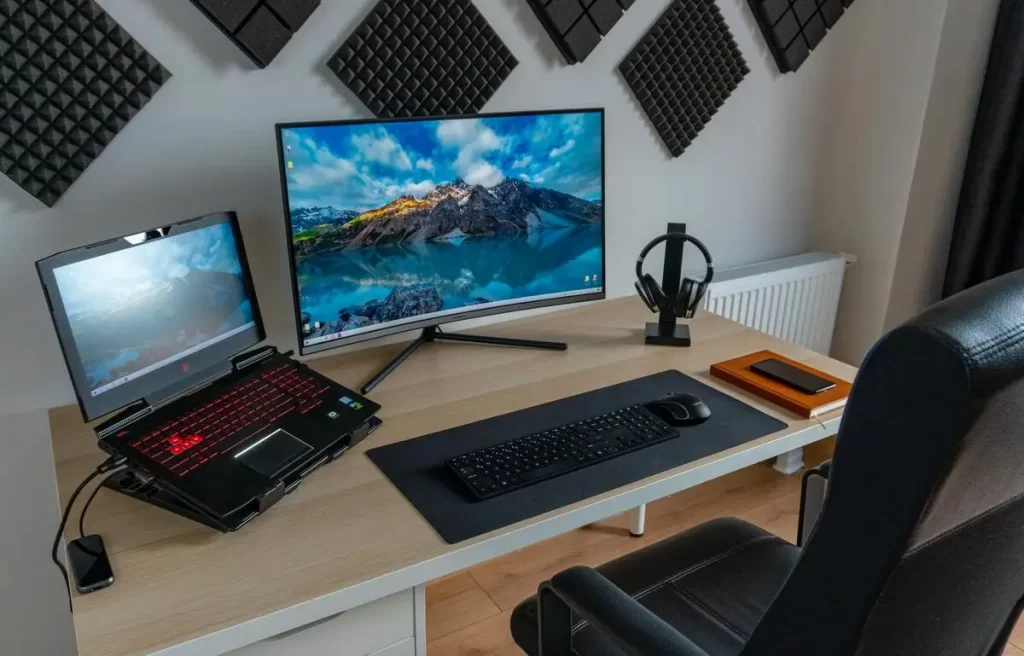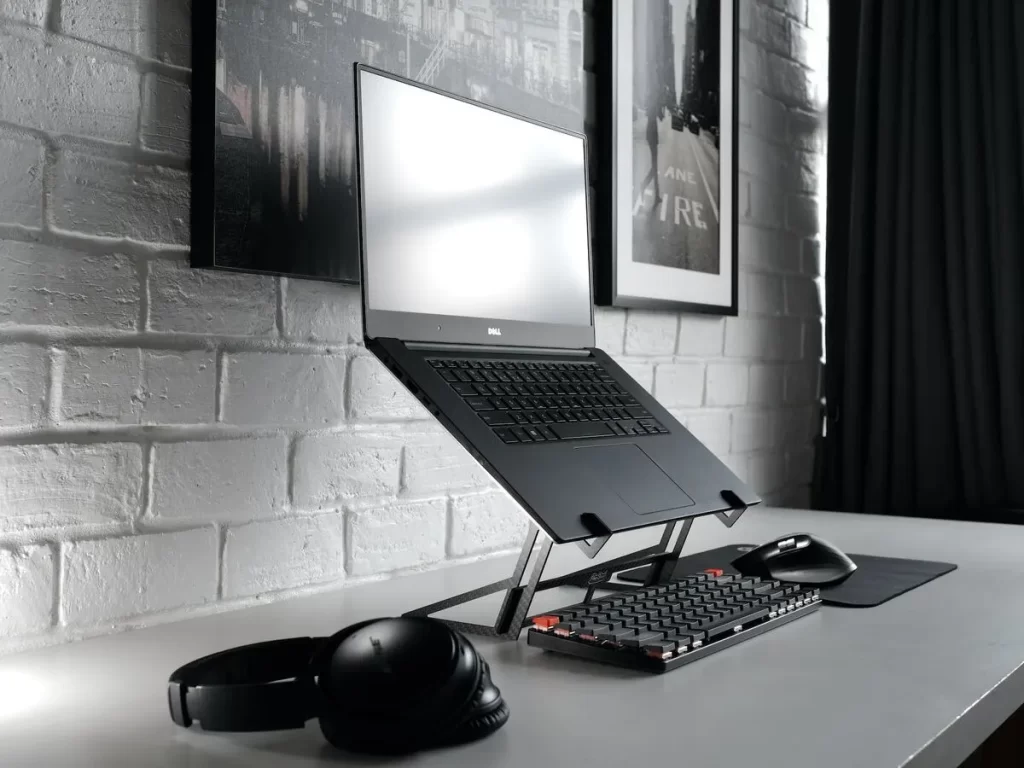
The pros of working outside of a typical corporate office is that you get to design your workspace. Unlike the constraints of your boring corporate office, this means you get to power up your desk setup with better and more devices.
A laptop is a common device we work with – many companies provide us with one – but is it sufficient? Should we consider a monitor for better productivity while working from home?
A laptop screen is smaller and designed for portability, while a monitor enables a larger display of apps and better multitasking. Both displays have their pros and cons, but having both devices is beneficial as you get to access both the aspects of portability and productivity.
Let’s quickly explore some key differences, some of which would matter more to us than others.
Laptop vs Monitor for Working from Home
As a remote worker, I love using a laptop with virtual desktops since I frequently work from different places – cafes, coffee shops, and my home office.
However, I recently started to optimize my monitor as I find it really beneficial to use the larger screen for specific tasks and programs, especially my spreadsheets. Some tasks are simply better done using a monitor.
Everyone has different needs and requirements that factor into their decision-making process.
As an overview, there are a few main factors to look at when deciding between a laptop or monitor screen: screen size, ergonomics, portability, performance, and power use, amongst other aspects.
Here is a side-by-side comparison of laptops and monitors so that you can decide how you prefer to work from home.
| Laptop | Monitor | |
| Screen size and Productivity | Laptops have smaller screens which can fit fewer apps, windows and programs. | Monitors are better for working on full-width applications such as spreadsheets and visual tools for web designers, video editors and programmers. |
| Portability | A laptop is designed for portability. | A monitor weighs more than a laptop and its larger screen size makes it hard to fit into your bags. (Exception: Portable monitors) |
| Ergonomics | A laptop comes with its screen and keyboard attached, so it is difficult to make ergonomic adjustments (that benefit both your eyes and wrists). | A monitor comes with only a display screen which can be height adjusted on a stand or arm. |
| Performance | A laptop performs worse than a desktop with similar specs. | A monitor paired with a desktop generally works faster than a laptop. |
| Power use | A single laptop uses less power than any setup that involves a monitor. | A monitor is not a standalone device; it uses power in addition to a laptop or desktop computer. |
Look through each factor – not every factor is important for your personal needs.
Arguably, the key differences for most people matter in terms of the optimal screen sizes for productivity and the need for portability.
This article was originally published on unboundist.com. If it is now published on any other site, it was done without permission from the copyright owner.
Screen size and productivity
How often have you found yourself wishing that there was more space on your small laptop screen?
Sometimes, you just need a little extra space to view 2 separate browser windows, to copy/paste information, or to watch a video while taking notes without having to switch tabs or windows.
In reality, we often need to work on multiple tasks at once. Monitors are better for multitasking since they let you fit more apps, windows and programs on one screen.
Compared to 13-15 inch laptops, most monitors are 19-27 inches wide, and most people would be happy with screens at 24 inches for common office tasks.
There are even ultrawide monitors that go 32 inches or beyond and you may wonder if you need that much screen space for productive work.
A 32-inch monitor is larger than the average monitor; it enables even more apps, programs and windows to be displayed. It benefits your productivity provided that you are able to sit further away and view the entire screen comfortably.
To maximize screen space, connect a monitor to your laptop when you are back at your home office. This way, with a laptop and a monitor, you can reap benefits of both productivity and portability.
Portability and travel
If you work remotely, you might as well capitalize on the flexibility to work from different places – switching up work locations from time to time can improve your productivity.
Laptops are the clear winners when it comes to portability, compared to a regular monitor – a laptop is designed as your travel companion.
A monitor weighs more than a laptop and its larger screen size makes it hard to fit into your bags.
However, there are lighter monitors in the market and some of them are even lighter than your everyday laptop.
These monitors designed to be lightweight – known as portable monitors – are suitable for traveling and working from anywhere you like. A portable monitor is designed to fit into your everyday backpack. It serves as a second screen connected to your laptop.
A portable second screen helps you be more productive, so I would definitely recommend it. However, note that you would also need to pack a keyboard and mouse (and maybe a laptop stand for ergonomics), so all the weight adds up.
I would use a portable monitor when I travel, but I wouldn’t pack it into my everyday backpack when I am not traveling.
Ultimately, It is up to you. Make your decision based on how much weight you tolerate, and what helps you be most productive.
Ergonomics and health while working from home

Good ergonomics let you work more productively over longer hours – you do not strain your wrists, eyes, neck, and back.
To achieve good ergonomics, users of a monitor and keyboard are able to separate their screens from their typing surface.
This means you get to customize how high your monitor goes (you can raise its height on a stand or monitor arm), and yet have the keyboard positioned at where your wrists naturally end up.
But if you are purely a laptop user, you can accomplish the same only if you separate your laptop screen from your typing surface.
Fortunately, the bad ergonomics of using a laptop can be “corrected”: use a laptop stand to elevate your laptop screen, and use an external keyboard to accommodate your wrists.
However, you need to put in the extra effort to set this up.
At the end of the day, you can achieve good ergonomics and productivity, whether you are using a laptop or monitor.
Side note: If you suffer from eye strain, check out how using a laptop or monitor screen matters for protecting your eyes and the important habits to learn.
Performance
By default, a laptop is slower than a desktop computer; a laptop is not as powerful as a desktop functioning with similar specs. Desktops are manufactured with full-size parts compared to laptops.
Further, laptops constantly try to strike a balance between speed and battery life, which is a problem that desktops do not have.
So, forgoing the laptop, and instead using a desktop paired with a monitor, can be the best option for someone who works from home 95-100% of the time – without need or desire for mobility – and requires the very best computer speed.
Ask yourself: do you really need the speed of a PC?
This especially matters if you are someone who loves portability. What tasks are you performing on a laptop and do you really need a high processor speed?
Can you not find a way to speed up your laptop?
Power use
No doubt, using a single laptop uses less power than any setup that involves a monitor.
A monitor is not a standalone device; it uses power in addition to a laptop or desktop computer.
It is safe to assume that if you use a monitor paired with a desktop, your computer setup will consume at least 2-3 times as much power as a regular laptop alone.
The laptop is the clear winner in this aspect – it does not perform as well as a PC but it consumes less power.
Laptop vs monitor specs
Here are some additional specs for deciding between a laptop and monitor.
| Laptop | Monitor | |
| Screen size | 11-17 inches | 17-27 inches (Ultrawide monitors can go up to 50 inches) |
| Weight | 2-5 pounds | 5-10 pounds |
| Screen resolution | 720p, 1080p, 2K, 1440p, 4K, 8K | 720p, 1080p, 2K, 1440p, 4K, 8K |
| Panel type | TN, IPS, OLED | TN, VA, IPS, OLED |
| Power use | 15-45 Watts | 35 Watts and above for LCD monitors (Desktop computers use 60-250 Watts) |
Besides the factors I have covered like screen size, ergonomics and portability, you may be looking to optimize the type of screens you are using.
Notice that if you want to optimize for screen performance, both monitors and laptops enable you to do that.
You can opt for screen resolutions beyond the standard 1080p screens (also known as full HD) that many modern displays come with, such as 2K or 4K. Both laptops and monitors offer higher-quality IPS and OLED panels if you need to work on highly visual tasks like video editing or design.
If you want to explore the exact screen size, resolution, RAM, storage, and other factors that I recommend for a laptop, check out this article here.
Is a monitor necessary for a remote worker?
So we all know by now: using a monitor can improve your productivity while making your computer setup more ergonomic. Yet, do you really need a monitor when working from home?
A monitor is not necessary since there are alternatives such as virtual desktops for your laptop, alongside phones or tablets which can be used as additional screens. Yet, using 1-2 monitors is worthwhile. A larger screen enables multitasking and the optimal display of apps at full width.
At the end of the day, I think that a monitor is really beneficial. Yet, it is not essential.
Productive desk setups are often marketed with the appeal of monitors. But if you do not want to add a monitor to your desk, there are other ways to get things done.
It all depends on your workflow – perhaps the smaller screen of your phone is a sufficient working companion to your laptop.
Getting a monitor for your laptop
If you have the budget and desk space for a monitor, you should highly consider adding a monitor to your desk. Pair it with your mobile laptop.
Even as a mobile remote worker who is location independent, you will likely have a designated workspace – such as your home office or a co-working space you frequent. Thus, a regular monitor provides an additional screen that lets you get things done quicker, better, and more conveniently.
It gives you that additional option whenever you feel tired of the limited screen area of your laptop.
Just be sure to mitigate the downsides while you use your laptop and monitor in conjunction: Minimize clutter on your desk, take care of ergonomics, and be organized with the apps on your screen.
Ultimately, you can optimize both productivity and mobility as a remote worker.